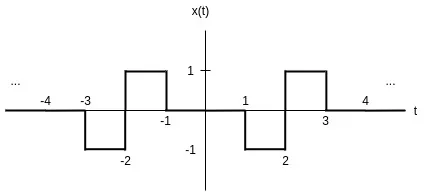
[Image1]
Introduction
Hey it's a me again @drifter1!
Today we continue with my mathematics series about Signals and Systems in order to cover Exercises on Continuous-Time Fourier Series.
So, without further ado, let's dive straight into it!
Continuous-Time Fourier Series Recap
Let's quickly refresh our knowledge on the Fourier Series. The Fourier Series is a way of representing periodic signals as a sum of weighted, harmonically related, complex exponentials. This procedure can be split into two parts:
- Fourier Synthesis
- Fourier Analysis
The Fourier Synthesis equation, which is the sum that forms the signal, is:

whilst the Fourier Analysis equation, which gives us the corresponding coefficients, is:

Fourier Series Coefficients Calculation [Based on 7.3 from Ref1]
For a fundamental frequency ωo = 2π, find the Fourier series coefficients for each of the following signals:

Solution
(a)
From Euler's Formula we know that a complex exponential can be turned into a sum of a sine and cosine trigonometric function, as follows:

As such, the cosine represents the real part of the complex exponential, whilst the sine represents the imaginary part.
Due to conjugate symmetry, relating the sine to the complex exponential is as simple as:

Thus, the signal x(t) can be re-written as:

Because the fundamental frequency is chosen to be 2π, the Fourier Series is of the form:

From the Euler expansion that we did for the signal, its easy to notice that only k = 4 and k = - 4 give non-zero results.
So, the final coefficients are:

(b)
The cosine signal can be represented in a similar sense using the following formula:

Using this representation the signal x(t) can be defined as:

which leads us to the following coefficients:

Fourier Series from Signal Graph [Based on 7.4 from Ref1]
Consider the following periodic signal:

Let's evaluate the Fourier series analysis equation.
Solution
From the graph its easy to notice that the period of the signal is To = 4 and so the fundamental frequency is:

Chosing a period of integration from - 2 to 2, can give us the Fourier coefficients as follows:

But, x(t) is inverse symmetrical when taken at - 2 to -1 and 1 to 2 correspondingly.
Let's also note that x(0) = 0.
Thus, its possible to re-write the formula as:

where x(t) is completely gone.
Let's continue with the calculations to find the final equation for the coefficients...

In order to calculate the value of ao, because it leads to 0 / 0, L'Hopital's rule can be applied.
RESOURCES:
References
Images
Mathematical equations used in this article were made using quicklatex.
Block diagrams and other visualizations were made using draw.io
Previous articles of the series
Basics
- Introduction → Signals, Systems
- Signal Basics → Signal Categorization, Basic Signal Types
- Signal Operations with Examples → Amplitude and Time Operations, Examples
- System Classification with Examples → System Classifications and Properties, Examples
- Sinusoidal and Complex Exponential Signals → Sinusoidal and Exponential Signals in Continuous and Discrete Time
LTI Systems and Convolution
- LTI System Response and Convolution → Linear System Interconnection (Cascade, Parallel, Feedback), Delayed Impulses, Convolution Sum and Integral
- LTI Convolution Properties → Commutative, Associative and Distributive Properties of LTI Convolution
- System Representation in Discrete-Time using Difference Equations → Linear Constant-Coefficient Difference Equations, Block Diagram Representation (Direct Form I and II)
- System Representation in Continuous-Time using Differential Equations → Linear Constant-Coefficient Differential Equations, Block Diagram Representation (Direct Form I and II)
- Exercises on LTI System Properties → Superposition, Impulse Response and System Classification Examples
- Exercise on Convolution → Discrete-Time Convolution Example with the help of visualizations
- Exercises on System Representation using Difference Equations → Simple Block Diagram to LCCDE Example, Direct Form I, II and LCCDE Example
- Exercises on System Representation using Differential Equations → Equation to Block Diagram Example, Direct Form I to Equation Example
Fourier Series and Transform
- Continuous-Time Periodic Signals & Fourier Series → Input Decomposition, Fourier Series, Analysis and Synthesis
- Continuous-Time Aperiodic Signals & Fourier Transform → Aperiodic Signals, Envelope Representation, Fourier and Inverse Fourier Transforms, Fourier Transform for Periodic Signals
- Continuous-Time Fourier Transform Properties → Linearity, Time-Shifting (Translation), Conjugate Symmetry, Time and Frequency Scaling, Duality, Differentiation and Integration, Parseval's Relation, Convolution and Multiplication Properties
- Discrete-Time Fourier Series & Transform → Getting into Discrete-Time, Fourier Series and Transform, Synthesis and Analysis Equations
- Discrete-Time Fourier Transform Properties → Differences with Continuous-Time, Periodicity, Linearity, Time and Frequency Shifting, Conjugate Summetry, Differencing and Accumulation, Time Reversal and Expansion, Differentation in Frequency, Convolution and Multiplication, Dualities
Final words | Next up
And this is actually it for today's post!
Next time we will get into exercises on the continuous-time Fourier transform!
See Ya!

Keep on drifting!
